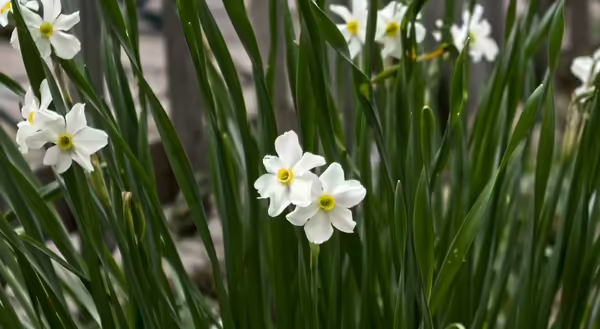
The delicate paperwhites, Narcissus papyraceus, are a lovely way to brighten winter days.
These relatives of the daffodil are an excellent choice for winter blooms as they don’t require a chilling period as other bulbs do.
Paperwhites have a cluster of small blooms at the end of a flower stalk (scape). The flowers can be white, bi-color, or doubles.
Paperwhites can have a strong fragrance. Some varieties have more of an odor than others. Two varieties with less scent are Ariel and Nir.
Many people love the scent, while others have a more negative reaction. Try different varieties to determine which is the best fit for your décor.
Care
Store the bulbs in a cool space at 55 to 60°F to maintain freshness. Consider buying in bulk and starting new bulbs every couple of weeks to have blooms all winter.
Getting Started
Paperwhites can be started in soil or on pebbles with water. Whichever option you choose, keeping them at cooler temperatures will allow them to develop strong roots. Place the bulbs close together, an inch or less apart, whether in soil or water.
Soil-less potting mix
Use a quality soil-less mix in a container with drainage holes. The growing media should be 4 to 5 inches deep. Add growing media around the bulbs leaving one-third of the bulb above the soil line.
Water thoroughly and allow excess water to drain. Monitor moisture levels and add water when the soil surface is dry.
Reblooming can be a challenge. After blooming, leave the leaves to produce food to replenish the bulb. The two most essential nutrients for bulbs are phosphorus and nitrogen.
Move plants outside when the weather warms, and the threat of frost is past. Acclimate the plants to the bright light gradually by first placing them in filtered light and moving to a sunny area.
As the leaves die back, you can trim them back. Withhold water to let the soil dry. Once the soil is dry, remove the bulb from the soil and return to a cool, dark space.
About a month before you would like to have blooms, move the bulb back to the potting mix, leaving one-third of the bulb above the soil line. Water thoroughly and place in a sunny window.
Pebbles
It is also possible to start the bulbs in pebbles. Keep in mind that paperwhites forced in pebbles are unlikely to rebloom.
Place the bulbs on the pebbles in the bottom of the container. Add pebbles between the bulbs to help support them. Fill with water to the base of the bulb. Once they have green shoot growth, move to a sunny window.
Bulbs forced in pebbles and water can be “pickled.” Research of this process from Cornell University has the bulbs start with water as described.
Once the green shoot growth is 1 to 2 inches, discard the water and refill it with a solution that has 4 to 6 % alcohol. Any distilled alcohol or rubbing alcohol can be used to make the solution. Avoid alcohol that has high sugar content as it promotes microbial growth.
This process will decrease the height of the flower stalk but not reduce the number or size of the flowers.
The shorter plants are less likely to need extra support. Discard the bulbs after the pickling process because they will not be able to rebloom.
Encouraging paperwhites to bloom can give your home a hint of spring during the cold winter days.
MEET THE AUTHOR
Nicole Flowers-Kimmerle is a Agriculture and Natural Resources (Horticulture) Educator for Fulton, Mason, Peoria and Tazewell counties. She completed a bachelors of science degree in crop science at the University of Illinois, and a master’s of science degree in agronomy with an emphasis in weed science at the University of Wisconsin-Madison. She has also worked at Montana State University as a research associate where she worked on weed control in sugar beets and barley. She taught high school chemistry and other science classes where she was able to teach students in both the school garden and greenhouse. She works with both the Extension Master Gardeners and Extension Master Naturalists.
ABOUT THE BLOG
ILRiverHort is a blog that helps people connect to nature and grow.